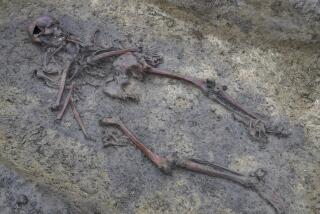An ancient Spanish civilization lives on
- Share via
NEW YORK — A new exhibit showcasing some of the earliest known human fossils in Europe touches on everything from cannibalism to sophisticated tools to a site known as the “pit of bones.”
“The First Europeans: Treasures From the Hills of Atapuerca” opens today at the American Museum of Natural History and is co-organized by the province of Castilla and Leon in Spain.
Containing fossils dating back 800,000 years, the exhibit illuminates the “complex and endlessly intriguing story of our origins,” said Ellen Futter, the museum’s president.
The ancient hominid and animal fossils and stone tools were discovered in the last 25 years at two neighboring sites in the Atapuerca hills in northern Spain. While scientific journals have published research about the finds, most of the fossils have never before been seen outside Spain.
“What we’ve learned from Spain is essentially the early history of the occupation of Europe. ... Nobody knew where early Europeans had come from,” said Ian Tattersall, co-curator of the exhibit and curator of the museum’s division of anthropology.
Today’s humans, Homo sapiens, are the only surviving species of the larger family known as hominids, which scientists say included the forerunners of modern humans.
The oldest well-dated European hominid fossil remains have been found at Gran Dolina, one of the Atapuerca sites, Tattersall said. Dated to 800,000 years ago, archeologists in 1997 declared the remains a new species -- Homo antecessor -- and theorized they were lanky, muscular beings who became the first hominids to migrate into the far reaches of Western Europe.
The species is represented in the exhibit by the fossil of “Gran Dolina boy,” which includes a partial skull and jaw and some sizable teeth.
Gran Dolina is also where archeologists found evidence of cannibalism, with cuttings, scrapings and chop marks on hominid bones similar to those found on animal bones. Fossils from these bones are also on display.
The second site at Atapuerca, known as the “pit of bones,” contains the largest and most complete accumulation of hominid bones ever recovered -- 30 individuals so far -- all dated to about 400,000 years ago.
The exhibit focuses on the mystery of how this virtually inaccessible pit became full of animal bones and the remains of mostly teenage and young adult hominids. Researchers believe the bones might have been intentionally thrown in the pit, but they don’t know why.
Among the exhibit’s other highlights are a beautiful rose-colored quartzite hand ax -- found in the pit and on public display for the first time -- and a room in which a model of the Gran Dolina archeological site is turned on its side, allowing the visitor to walk “back in time” through the layers of dirt and sediment.
The exhibit is on view through April 13.


